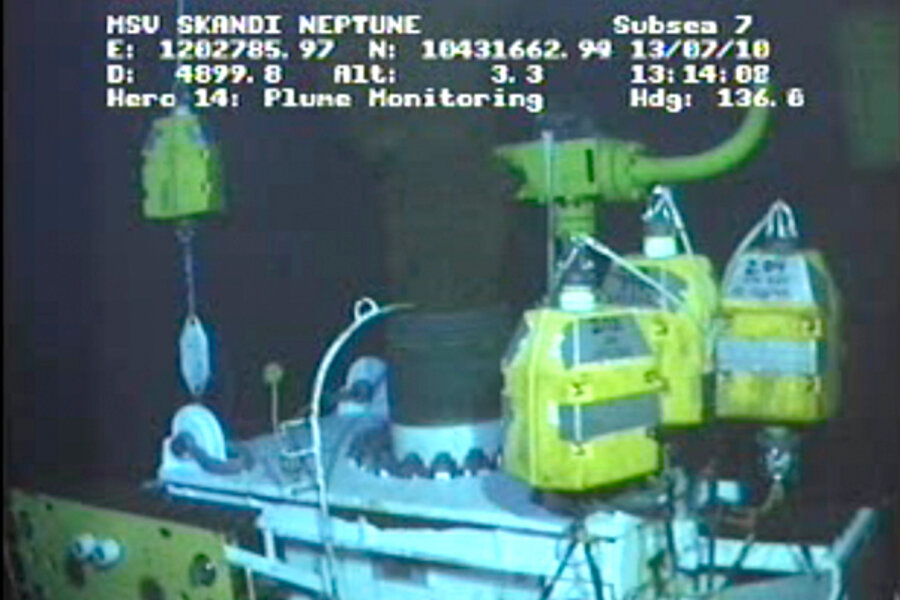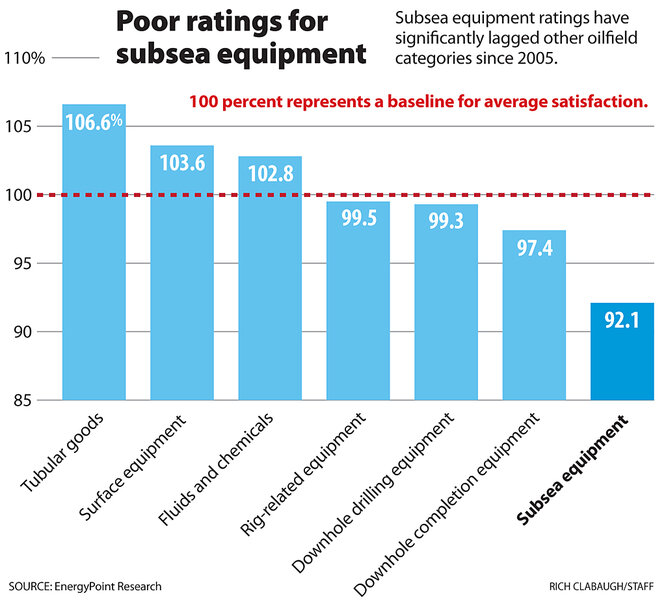Offshore drilling: industry rates its own equipment substandard
Loading...
Even as it opposes the Obama administration moratorium on offshore drilling, the oil industry has doubts about the quality and long-term viability of equipment that it uses to extract oil from deep-water wells, such as the one at the center of the Gulf oil spill.
In arguing for a moratorium, Interior Department Secretary Ken Salazar has said that "fundamental questions about deep-water safety" remain. The offshore industry counters that the amount of crude spilled and the number of spills hit a record low this past decade.
Yet both industry experts and managerial personnel acknowledge that the technology used to remove offshore oil from its reservoirs – particularly in deep water – has been outstripped by engineers' ability to find and drill for that oil.
That has left members of the oil industry dissatisfied with the tools they need to work in one of earth's most challenging environments. While there is no evidence yet that equipment was to blame for the Deepwater Horizon blowout, some industry experts say the quality of deep-water extraction technology is increasingly becoming a concern.
"We believe that the quality, reliability and adequacy of subsea equipment is a potential weak link in the deep-water equation going forward," said a recent report from EnergyPoint Research, an oil-industry marketing company in Houston.
Poor scores in industry survey
Since 2005, subsea equipment has received the lowest annual overall satisfaction rating of the seven oilfield segments tracked by EnergyPoint. While oil company leaders rated every other equipment category above or just slightly below the average overall industry rating – defined by the survey company as 100 percent – subsea equipment scored at 92.1 percent. The next-worst category, downhole completion equipment, scored 5.3 percentage points higher.
In relating the figures to an academic letter grading system, EnergyPoint’s managing director Douglas Sheridan said subsea equipment would be in the D range, close to an F, while every other equipment category surveyed is in the B range.
Among all subsea products surveyed, blowout preventers – the safety device that failed at the Deepwater Horizon's Macondo well – have the lowest satisfaction rating.
Clearly, the industry's improving safety record during the past decade suggests that low satisfaction does not necessarily equate to more accidents. But the low satisfaction does point to a troubling trend in the industry.
Until this past decade, offshore exploratory work looking for wells in areas that have not previously been drilled into for oil was largely ignored because it was less cost effective and riskier than extracting oil either on land or around existing offshore wells in shallower waters. As a result, investment in offshore-equipment research lagged.
This decade, however, the depletion of existing oil reserves and an increase in demand have driven companies into deeper waters.
Research on deep-water equipment lagging
Dramatic advances in seismic technology have allowed scientists to find remoter reserves more easily, says Hans Juvkam-Wold, professor emeritus in petroleum engineering at Texas A&M University.
But investment in new equipment technology to extract the harder-to-get oil has not kept pace, says James Pappas, vice president for technology at the Research Partnership to Secure Energy for America.
For example, the harsher, less predictable conditions in deep water can have an effect on sensitive fluids that are crucial to drilling, meaning that alternatives need to be developed, says Mr. Pappas.
Moreover, the deep sea remains one of the least explored places on earth, meaning that engineers must rely on estimates in devising deep-water equipment that will be used in environments that can vary greatly depending on where and how deep a company is drilling.
In deeper waters, thick layers of impermeable salt common in the Gulf of Mexico can make the process more complex in nearly every phase. Salt is tougher to drill through, it can be a sign of oil under higher amounts of pressure, and it can add to corrosion of subsea equipment.
Still low market demand
Because deep-water drilling is still a small fraction of overall drilling, the market for better equipment is small, says Iraj Ershaghi, director of the petroleum engineering program at the University of Southern California in Los Angeles.
Additionally, the oil industry is generally conservative when it comes to adopting technologically enhanced equipment, he said. Many in the industry feel new devices take away from the sense of familiarity and comfort with the equipment they already work with, and thus increase risk.
But there is a realization that the lack of quality deep-water extraction equipment needs to be addressed. While subsea equipment has improved in recent years, "it still may not be quite good enough to get the job done safely," says EnergyPoint's Mr. Sheridan.
Others feel the equipment is adequate, for now, but that new research is needed for the future.
"Equipment-wise, we are OK now," says Dr. Ershaghi. But "it's getting tougher and tougher and tougher [to extract subsea oil]. We need better technology."
Related:






